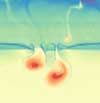 |
LIP formation and protracted lower mantle upwelling induced by rifting and delamination |
Kenni D. Petersen1, Christian Schiffer2,3, Thorsten Nagel1
1Department of Geoscience, Aarhus University, 8000 Aarhus, Denmarlk; kenni@geo.au.dk ; thorsten.nagel@geo.au.dk
2Department of Earth Sciences, Durham University, Durham DH1 3LE, United Kingdom; christian.schiffer@zoho.com
3Department of Earth Sciences, Uppsala University, 752 36 Uppsala, Sweden;
This webpage is a summary of Petersen, K.D., and Schiffer, C., and Nagel, T. 2018, LIP formation and protracted lower mantle upwelling induced by rifting and delamination Scientific Reports, 398, Article number 16578, 131-144, doi: 10.1038/s41598-018-34194-0
The motivation for this study was to explore possible relations between LIPs and rifting in tectonic settings where extension is associated with the presence of older orogenic sutures. For example, in the North Atlantic, breakup was likely governed by the scar left by the Caledonian orogeny (e.g., Schiffer et al., 2015). Along the present-day North Atlantic margins, several studies have interpreted lower crustal bodies (LCBs) with seismic velocities often exceeding typical uppermost mantle values as eclogite or granulite-facies mafic bodies (Mjelde et al., 2013).
In a recent study (Petersen & Schiffer, 2016) we developed thermomechanical rift models where the effects of different pre-rift configurations were explored (http://www.mantleplumes.org/OrogenicInheritance.html). We noted that in some cases, when eclogite bodies were present at the base of the pre-rift crust, delamination of the eclogite body as well as the adjacent mantle lithosphere is induced during extension. It has been proposed elsewhere that delamination can cause rapid uplift and magmatism (Elkins-Tanton, 2005) and also that it can be induced during lithospheric extension (Meissner & Mooney, 1998). In order to test whether such rift-induced delamination could explain the vast amounts of magma generated during the formation of the North Atlantic (Storey et al., 2007) we conducted a series of rift simulations where the effects of different sizes and compositions of LCBs were explored. These simulations all indicated that high melt-productivity can result from rapid delamination and the resultant small-scale convection. However, the total volumes of melt produced during North Atlantic breakup, as well as the elevated melt productivity that continues at Iceland, cannot be explained by a rapid delamination event (see also review by Meyer et al., 2007).
An additional prediction of our simulations is that the detached lithosphere is capable of sinking into the lower mantle within a few Ma due to its detachment from the overhead plate and its negative buoyancy. If the thermal boundary layer at the 660 discontinuity under the early Atlantic rift system was capable of preserving higher potential temperatures in the lower mantle (e.g., Davies, 2008) it is possible that rapid sinking of lithospheric material through the discontinuity would perturb the thermal stratification, induce upwelling from the lower mantle, and thereby cause elevated rates of magmatism.
As described in Petersen et al. (2018), we explore this hypothesis. We set up a two-dimensional, 2000 x 2000-km box model of the upper mantle/lithosphere system and part of the lower mantle. We account for temperature- and pressure-dependent thermodynamic properties (density and entropy) by employing tabulated values calculated in Perple_X (Connolly, 2005) using the database of Stixrude & Lithgow-Bertelloni (2011). The model is inititated with a thermal structure that corresponds to a conductive lithosphere 150 km thick, a sublithospheric upper mantle with a potential temperature (Tp) of 1325°C and a lower mantle with Tp =1525°C. In the center of the model the lithosphere is assumed to contain a 600-km-wide orogen. The orogen has continental crust 10 km thicker than the surrounding region and is underlain by a 20-km-thick LCB with a mafic MORB-like composition.
The density of the mantle is assumed to be pyrolitic (Ringwood, 1979) except for the mafic LCB beneath the orogen and bodies of MORB assumed to represent trapped MORB at the upper/lower mantle boundary (Irifune & Ringwood, 1993; Karato, 1997; Ringwood & Irifune, 1988). The density difference between these two compositions (pyrolite and MORB) is shown in Figure 1.
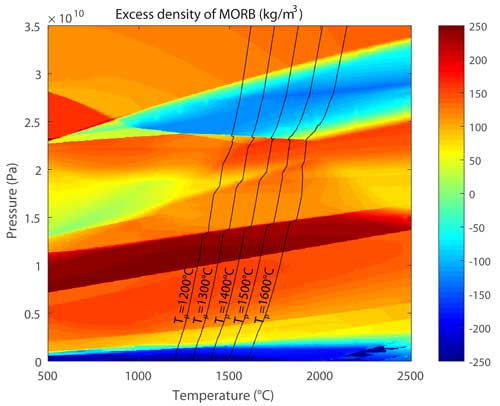
Figure 1: Temperature- and pressure-dependent density differences between the MORB and pyrolite compositions for the upper mantle and top part of the lower mantle, employed in this study. Black, superimposed curves show pyrolite adiabats (isentropes) for selected potential temperatures (Tp). Density and entropy maps are calculated using Perple_X (Connolly, 2005) and the thermodynamic database of Stixrude and Lithgow-Bertelloni (2011).
Tectonic quiescence with a horizontal velocity field of 0 across vertical model boundaries is assumed during the first 300 Myr of the simulation. During this period, vigorous and continuous convection develops in the upper mantle, while the lower mantle and the lithosphere remain stagnant. The mechanical separation between the upper and lower mantle due to phase transitions and compositional stratification persists, and the lower mantle retains an elevated Tp (Figure 2a). Also, the partly eclogitised and negatively buoyant lower crust in the orogen remains metastable against delamination due to the high strength of the cold mantle lithosphere (Figure 2a-c).
At 300 Myr, extension is applied and the orogenic lithosphere begins to thin. During the first 9 Myr of extension, strain localises in a 200-km-wide rift zone with a lithospheric thinning-factor of 2-3. Lithosphere thinning is associated with increasing horizontal density gradients between the lithosphere and asthenosphere, promoting convective instabilities proximal to the rift (Buck, 1986). These instabilities are enhanced by the presence of the dense eclogitic lower crust. As extension progresses abrupt delamination of the lithospheric mantle from the crust occurs (Elkins-Tanton, 2005; Meissner & Mooney, 1998) as two separate drips form within 2 Myr. The resulting asthenospheric counterflow causes a short-lived pulse of decompression melting (Figures 2d & 5).
Within 2 Myr, the delaminated lithosphere sinks through the upper mantle, reaches the MTZ and penetrates the upper/lower mantle boundary. This perturbs the metastable thermomechanical boundary layer and hot, buoyant lower mantle material rises to the rift zone causing voluminous melting (Figure 2g; Figure 4). The time between delamination and the onset of decompression melting of lower mantle upwellings is 6 Myr, and within 0.3 Myr, melt productivity reaches 280 km, 40 times average mid ocean ridge productivity (White et al., 1992; Figure 4). The high productivity is a consequence of both a large upwards flux of lower mantle material and its high Tp.
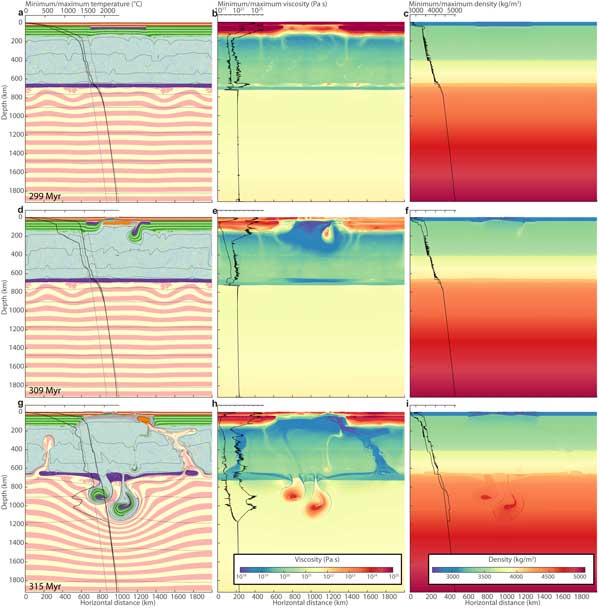
Figure 2: Lithology, viscosity and density evolution. First row shows lithology (a), viscosity (b) and density structure (c) 1 Myr prior to the onset of extension. In (a), colour striping is used to discriminate between crust (light orange), mantle lithosphere (green), upper mantle (light blue) and lower mantle (yellow/pink) and to show strain since model onset. Purple indicates mafic material, bright orange indicates regions were melts are currently forming, and grey tones with white text (shown in Figure 3) show total degree of melt depletion of mantle material that melted at earlier stages of the model run. Thin black lines are isotherms, and bold black lines are minimum and maximum temperature as functions of depth. For comparison, grey curves show theoretical adiabats for Tp's of 1300 and 1500°C, respectively. Black lines in (b) and (c) show profiles of minimum and maximum values of viscosity and density and viscosity, respectively, as a function of depth. (d-f) show the same parameters for 9 Myr after the onset of extension. (g-i) show the same parameters for 15 Myr after the onset of extension. Click here or on Figure for enlargement.
Following this, melt production decreases, but still remains relatively high compared ‘typical’ oceanic values at about ~10-25 km. The continued high productivity is due to continued upwelling from the lower mantle.
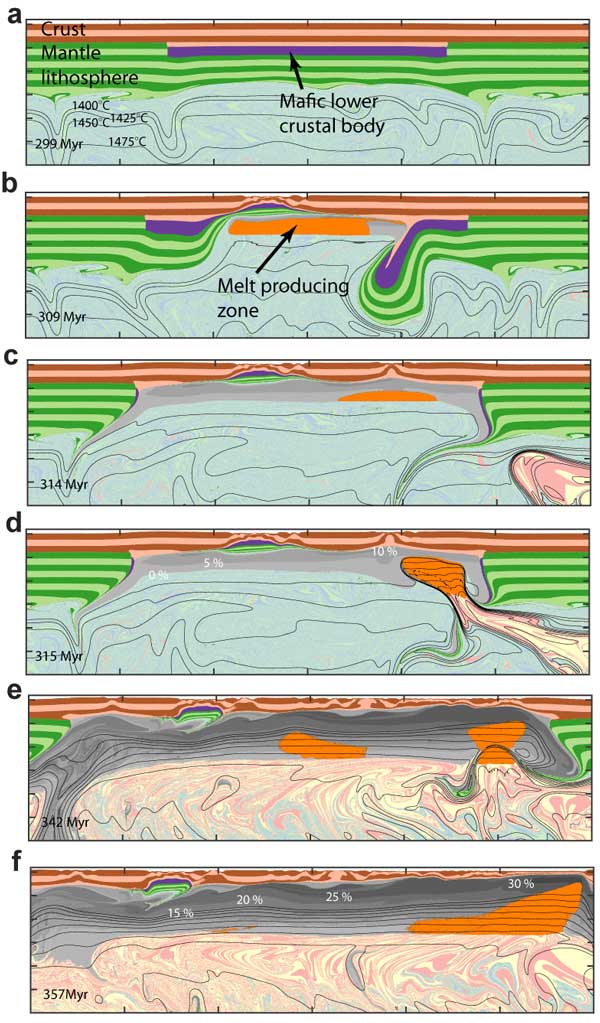
Figure 3: Detail of lithology evolution in the center of the modeling domain down to a depth of 300 km. Colors as in Figure 2a,d,g, but stiuations at (a) -1,(b) 9, (c) 14, (d) 15, (e) 42 and (f) 57 Myr after onset of extension are shown.
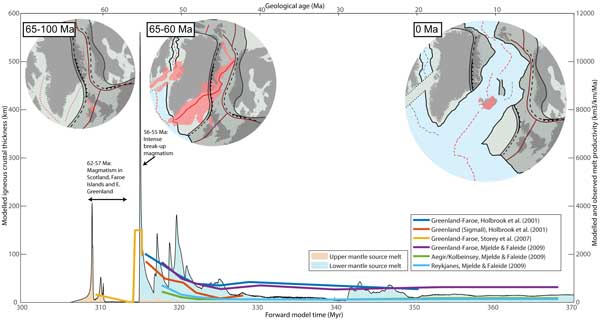
Figure 4: Black curve outlining pink or blue area shows model time (lower x-axis) vs. melt productivity and source (upper and lower mantle, respectively) of the model shown in Figures 2-4. Thick, coloured curves show age (upper x-axis) of Cenozoic melt productivity estimates in the vicinity of present-day Iceland (Holbrook et al., 2001; Mjelde & Faleide, 2009; Storey et al., 2007). A model time of 370.5 Myr is assumed to correspond to the present (0 Ma) for comparison with the NAIP. Circular insets show plate reconstructions with locations of rift zones, approximate outlines of major magmatic activity and locations of Caledonian structures. Click here or on Figure for enlargement.
The modelled melt productivity curve is characterized by pulses of high productivity. Such pulses are a consequence of a non-steady flow of material from the lower mantle as well as its modulation by/interaction with small-scale convection in the upper mantle. Pulsing is most pronounced during the first 15 Myr of lower mantle upwelling (i.e. at 315-330 Myr), after which melt productivity becomes more steady.
The results presented here indicate that the above suggested hypothesis is physically feasible. A LIP such as the NAIP and the protracted high rate of post-breakup magmatism can both be attributed to destabilization of the lower/upper mantle boundary that was initiated by rift-induced delamination during the onset of extension of the North Atlantic in the early Paleogene. Such an explanation would be consistent with 1) apparent high temperature and anomalous composition of the mantle source of NAIP melts, 2) apparent correlation between the NAIP and the intersection between Caledonian structures and the embroyonic North Atlanlic rift system, and 3) protracted high magmatic activity since beginning during LIP formation at ~55 Ma and continuing today at present-day Iceland.
A corollary result of this study is that the delocalized ‘wide-rift’ mode/phase of extension that is known to develop if the crust is initially thick and weak, (Buck, 1991), can be substantially prolonged if extension is associated with delamination. Removal of the mantle lithosphere brings the lower crust in contact with >1300°C mantle, resulting and rapid heating and therefore weakening of the lower crust. The effect of protracted wide-rift mode extension is evident in Figure 3f where it can be seen that complete rupture of the continental crust has not yet developed 57 Myr after the onset of extension. This mechanism could explain why there are possibly still substantial remnants of continental crust beneath the Greenland-Iceland-Faroe Ridge (Foulger et al., 2019).
References
- Buck, R. W., 1986, Small-scale convection induced by passive rifting: the cause for uplift of rift shoulders: Earth and Planetary Science Letters, v. 77, no. 3-4, p. 362-372.
- Connolly, J., 2005, Computation of phase equilibria by linear programming: a tool for geodynamic modeling and its application to subduction zone decarbonation: Earth and Planetary Science Letters, v. 236, no. 1, p. 524-541.
- Davies, G. F., 2008, Episodic layering of the early mantle by the ‘basalt barrier’ mechanism: Earth and Planetary Science Letters, v. 275, no. 3, p. 382-392.
- Elkins-Tanton, L. T., 2005, Continental magmatism caused by lithospheric delamination, in Plates, Plumes, and Paradigms, edited by G. R. Foulger, J. H. Natland, D. C. Presnall and D. L. Anderson, pp. 449-462, Geological Society of America Special Papers, v. 388, p. 449-461.
- Foulger, G. R., T. Doré, C. H. Emeleus, D. Franke, L. Geoffroy, L. Gernigon, R. Hey, R. E. Holdsworth, M. Hole, Á. Höskuldsson, B. Julian, N. Kusznir, F. Martinez, J. H. Natland, A. Peace, K. Petersen, C. Schiffer, R. Stephenson, and M. Stoker, A continental Greenland-Iceland-Faroe Ridge, Earth-Science Reviews, submitted.
- Holbrook, W. S., Larsen, H., Korenaga, J., Dahl-Jensen, T., Reid, I. D., Kelemen, P., Hopper, J., Kent, G., Lizarralde, D., and Bernstein, S., 2001, Mantle thermal structure and active upwelling during continental breakup in the North Atlantic: Earth and Planetary Science Letters, v. 190, no. 3, p. 251-266.
- Irifune, T., and Ringwood, A. E., 1993, Phase transformations in subducted oceanic crust and buoyancy relationships at depths of 600–800 km in the mantle: Earth and Planetary Science Letters, v. 117, no. 1, p. 101-110.
- Karato, S.-i., 1997, On the separation of crustal component from subducted oceanic lithosphere near the 660 km discontinuity: Physics of the Earth and Planetary Interiors, v. 99, no. 1, p. 103-111.
- Meissner, R., and Mooney, W., 1998, Weakness of the lower continental crust: a condition for delamination, uplift, and escape: Tectonophysics, v. 296, no. 1, p. 47-60.
- Meyer, R., van Wijk, J., and Gernigon, L., 2007, The North Atlantic Igneous Province: A review of models for its formation: in Plates, Plumes, and Planetary Processes, edited by G.R. Foulger and D.M Jurdy, Geological Society of America Special Papers, v. 430, pp. 525-552.
- Mjelde, R., and Faleide, J. I., 2009, Variation of Icelandic and Hawaiian magmatism: evidence for co-pulsation of mantle plumes?: Marine Geophysical Researches, v. 30, no. 1, p. 61-72.
- Mjelde, R., Goncharov, A., and Müller, R. D., 2013, The Moho: Boundary above upper mantle peridotites or lower crustal eclogites? A global review and new interpretations for passive margins: Tectonophysics, v. 609, no. 0, p. 636-650.
- Petersen, K. D., and Schiffer, C., 2016, Wilson cycle passive margins: Control of orogenic inheritance on continental breakup: Gondwana Research, v. 39, p. 131-144.
- Petersen, K. D., Schiffer, C., and Nagel, T., 2018, LIP formation and protracted lower mantle upwelling induced by rifting and delamination: Scientific Reports, v. 8, no. 1, p. 16578.
- Ringwood, A., 1979, Origin of the Earth and Moon, Spring-Verlag, New York, 295 p.:
- Ringwood, A. E., and Irifune, T., 1988, Nature of the 650-km seismic discontinuity: implications for mantle dynamics and differentiation: Nature, v. 331, no. 6152, p. 131-136.
- Schiffer, C., Stephenson, R. A., Petersen, K. D., Nielsen, S. B., Jacobsen, B. H., Balling, N., and Macdonald, D. I. M., 2015, A sub-crustal piercing point for North Atlantic reconstructions and tectonic implications: Geology, v. 43, no. 12, p. 1087-1090.
- Stixrude, L., and Lithgow-Bertelloni, C., 2011, Thermodynamics of mantle minerals - II. Phase equilibria: Geophysical Journal International, v. 184, no. 3, p. 1180-1213.
- Storey, M., Duncan, R. A., and Swisher, C. C., 2007, Paleocene-Eocene thermal maximum and the opening of the northeast Atlantic: Science, v. 316, no. 5824, p. 587-589.
- White, R. S., McKenzie, D., and O'Nions, R. K., 1992, Oceanic crustal thickness from seismic measurements and rare earth element inversions: Journal of Geophysical Research: Solid Earth, v. 97, no. B13, p. 19683-19715.
last updated 11th
March, 2019
|
